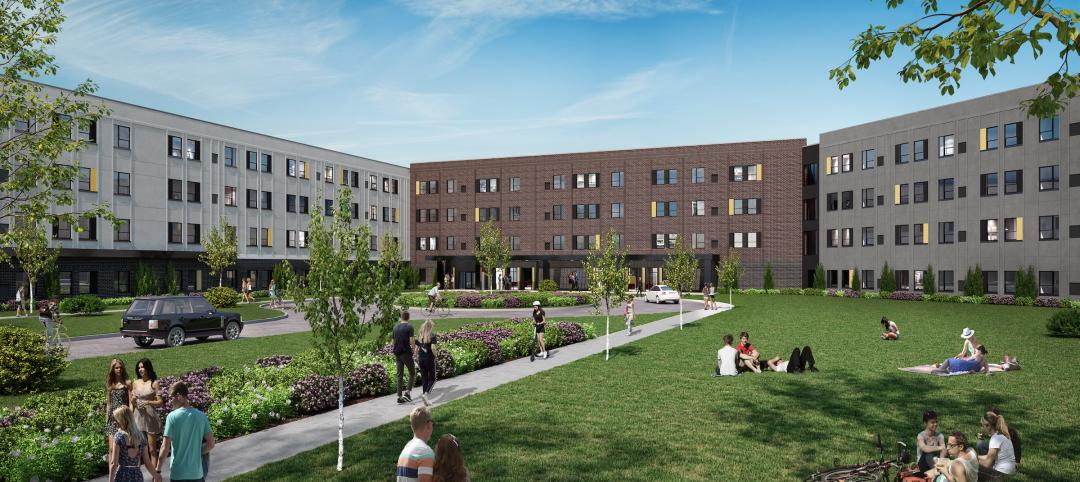Imagine a future in which you could access building information modeling technology anywhere, at any time. A future in which you could tap unlimited computing resources with the click of a mouse and crack even the most complex building analysis task with virtually no delay.
Imagine a future in which collaboration would be painless, integration seamless, and access to architecture, engineering, and construction expertise limitless. Finally, imagine a future where the ability to plug-and-play business partners into your project teams could be done with almost no effort.
At first, this might sound too good to be true. But just as BIM has significantly enhanced how Building Teams plan, deliver, and manage the built environment, cloud computing is now set to revolutionize BIM. According to “Sizing the Cloud,” an April 2011 research paper by Stefan Reid (published by Forrester Research), the global market for cloud computing will reach $241 billion in 2020. Clearly, cloud computing is poised to challenge traditional business models and create substantial opportunities globally for AEC firms.
Defining the cloud
The traditional approach to computing involves buying hardware—laptops, servers, routers, modems, switches, and so on—and software, then bringing in support personnel and project managers to tackle everything from integrating BIM systems to upgrading procurement tools, all under the direction of a chief information officer.
In contrast, cloud computing delivers computing as a service rather than as a physical product. Essentially, it enables AEC firms to rent computing infrastructure, software, and systems through the Internet on an as-needed basis, thereby liberating design and construction firms from much of the traditional cost and bother of IT infrastructure.
Such a setup has several unique properties that give cloud computing the capability to transform the nonresidential design and construction sector:
• Ubiquitous access — The ability to access project information and software functionality on any device, from any connected location, at any time.
• Infinite computing — The cloud is infinitely scalable, at least in terms of computing firepower that can be directed at your processing requirements. This means the traditional bottlenecks created by how much capability you can pack into a single desktop PC are now sidestepped, unleashing a whole new era of supercomputing.
• Evergreen service marketplace — The cloud is a democratic environment, enabling anyone to package up knowledge as a service and become a service provider. The recent explosion in smart phone apps is just one example. Now imagine the power of accessing the most current knowledge from across the AEC sector’s constituency.
BIM and the cloud
So, what happens when BIM processes enter the cloud? First, some of the traditional challenges that AEC firms encounter when implementing BIM are neatly sidestepped. Frequently, this occurs as a result of model collaboration, as well as the well-known limitations of desktop computing power to handle data-heavy models. “BIM enables a virtual design and construction process,” says Jonathan Mallie, principal and managing director at New York City-based SHoP Construction (www.shop-construction.com), an industry leader in integrating emerging technologies. “We see the use of cloud computing as a way to better use BIM in the VDC process.”
Second, and more significantly, BIM in the cloud helps reshape the competitive landscape across AEC, enabling any company in the supply chain to offer BIM-based services. Consider the following:
• Information collaboration — With a model located in the cloud supporting concurrent, controlled access and manipulation of all project information, the overhead associated with exchanging models and managing information integrity across the project constituency evaporates. There is one model, one version.
As project integrator, SHoP Construction is currently implementing a Web-based BIM management tool on the B2 Modular Housing Project in the Atlantic Yards in Brooklyn, N.Y. “We envision the model becoming a visual database of searchable project information, much like an Internet search engine,” says Mallie. “The Internet wouldn’t be very useful if it only had one person on it. The more stakeholders contributing to the model, the more valuable that model becomes.”
• Business collaboration — Accessing complete information through cloud-based services while more easily and effectively collaborating with new business partners on your project offers the potential to significantly improve the traditional relationship between Building Team member firms. Conversely, there’s the possibility to be a provider of that knowledge via one or more BIM services. Got a process for determining total cost of ownership for energy use or carbon analysis? Offer it as a BIM service.
Working on the Barclays Center Arena in Brooklyn, SHoP prototyped a Web-based portal to enable project stakeholders to track the fabrication and installation progress of no less than 12,000 uniquely sized steel panels for the arena’s façade. “The constantly updated 4D model evolved into a critical tool for the design-build team to understand where we were in production and how schedule changes would impact installation,” says Mallie. “What was initiated for internal use developed into a teamwide collaborative process.”
• Iteration — As BIM’s capability moves beyond the spatial processes of physical coordination into realms of the open-ended analytical, the need to undertake concurrent, exhaustive analysis across multiple dimensions (energy, carbon, whole-life cost, maintainability, etc.) continues to grow. Crunching vast amounts of data isn’t feasible in a desktop environment. Accessing the cloud’s infinite computing capabilities, however, enables Building Teams to optimize design across all constraints.
• Scalability — With the varying workload profile in the AEC environment, it can be tricky to get the size and mix of your so-called “IT estate” just right. Though a certain minimum level is always needed, the on-demand rental nature of the cloud helps you better flex along with your workload. A significant section of your hardware, software, and even support components can be more rationally aligned with your workload.
Opening new windows of opportunity
As BIM enters the cloud, the process is primed to provide efficiency and productivity benefits across the asset life cycle; it will significantly accelerate the manner in which the AEC sector plans, builds, and manages the built environment. BIM will also give rise to a range of new opportunities for AEC sector businesses to become service providers.
Five years ago, “clash detection” was a largely unknown term, while BIM was still the stuff of theory. “In the early phase of BIM, the challenge was to generate the information,” says SHoP’s Mallie. “Now, we have a great deal of data, and the true challenge is to manage and use that data most effectively. The cloud is an important tool in helping us do just that.”
Make no mistake: The AEC industry is on the cusp of a still more significant evolution with cloud computing. +
--
Dominic Thasarathar is a Senior Industry Program Manager for Construction at Autodesk, Inc.
Related Stories
University Buildings | Jun 28, 2024
The American University in Cairo launches a 270,000-sf expansion of its campus in New Cairo, Egypt
In New Cairo, Egypt, The American University in Cairo (AUC) has broken ground on a roughly 270,000-sf expansion of its campus. The project encompasses two new buildings intended to enhance the physical campus and support AUC’s mission to provide top-tier education and research.
MFPRO+ New Projects | Jun 27, 2024
Chicago’s long-vacant Spire site will be home to a two-tower residential development
In downtown Chicago, the site of the planned Chicago Spire, at the confluence of Lake Michigan and the Chicago River, has sat vacant since construction ceased in the wake of the Great Recession. In the next few years, the site will be home to a new two-tower residential development, 400 Lake Shore.
Codes and Standards | Jun 27, 2024
Berkeley, Calif., voters will decide whether to tax large buildings with gas hookups
After a court struck down a first-in-the-nation ban on gas hookups in new buildings last year, voters in Berkeley, Calif., will have their say in November on a measure to tax large buildings that use natural gas.
Mass Timber | Jun 26, 2024
Oregon State University builds a first-of-its-kind mass timber research lab
In Corvallis, Oreg., the Jen-Hsun Huang and Lori Mills Huang Collaborative Innovation Complex at Oregon State University aims to achieve a distinction among the world’s experimental research labs: It will be the first all-mass-timber lab meeting rigorous vibration criteria (2000 micro-inches per second, or MIPS).
Sustainability | Jun 26, 2024
5 ways ESG can influence design and create opportunities
Gensler sustainability leaders Stacey Olson, Anthony Brower, and Audrey Handelman share five ways they're rethinking designing for ESG, using a science-based approach that can impact the ESG value chain.
Student Housing | Jun 25, 2024
P3 student housing project with 176 units slated for Purdue University Fort Wayne
A public/private partnership will fund a four-story, 213,000 sf apartment complex on Purdue University Fort Wayne’s (PFW’s) North Campus in Fort Wayne, Indiana. The P3 entity was formed exclusively for this property.
Sustainability | Jun 24, 2024
CBRE to use Climate X platform to help clients calculate climate-related risks
CBRE will use risk analysis platform Climate X to provide climate risk data to commercial renters and property owners. The agreement will help clients calculate climate-related risks and return on investments for retrofits or acquisitions that can boost resiliency.
MFPRO+ News | Jun 24, 2024
‘Yes in God’s Backyard’ movement could create more affordable housing
The so-called “Yes in God’s Backyard” (YIGBY) movement, where houses of worship convert their properties to housing, could help alleviate the serious housing crisis affecting many communities around the country.
Student Housing | Jun 20, 2024
How student housing developments are evolving to meet new expectations
The days of uninspired dorm rooms with little more than a bed and a communal bathroom down the hall are long gone. Students increasingly seek inclusive design, communities to enhance learning and living, and a focus on wellness that encompasses everything from meditation spaces to mental health resources.
Museums | Jun 20, 2024
Connecticut’s Bruce Museum more than doubles its size with a 42,000-sf, three-floor addition
In Greenwich, Conn., the Bruce Museum, a multidisciplinary institution highlighting art, science, and history, has undergone a campus revitalization and expansion that more than doubles the museum’s size. Designed by EskewDumezRipple and built by Turner Construction, the project includes a 42,000-sf, three-floor addition as well as a comprehensive renovation of the 32,500-sf museum, which was originally built as a private home in the mid-19th century and expanded in the early 1990s.

















